
To be able to welcome, for centuries, followers at the coronation of the King of France, the builders of the Middle Ages imagined in Reims, a cathedral of Gothic architecture that is simply beyond comprehension.
The greatest specialists of their time put together their genius to work and invented many construction techniques.
With more than 1 million visitors a year, who also come to see the thousands of statues on its facade, this immense stone vessel is the longest of all French cathedrals and its towers exceed in size those of the cathedral of Paris, the famous Notre-Dame-de-Paris!
Reims Cathedral is a XIII century masterpiece, one of the most incredible religious building of France. The sheer size of its dimension, the architecture, is beyond understanding. At the time it was built, it was the largest and tallest of all cathedrals.
To build this gigantic stonework, the builders of the Middle Ages used the most innovative techniques of their time. The pillars, arcades, staircases etc.… are much more imposing than in any other cathedral built during that time period.
To say the least, the architecture of Notre-Dame-de-Reims represents the zenith of the gothic art! It’s an architecture of lines and lights and if it has such an exceptional character, it’s because it welcomed the coronation of the majority of the Kings of France. To be precise, 33 Kings of France were crowned there before celebrating the coronation at the Palace of Tau, today part of the UNESCO World Heritage.
Notre-Dame-de-Reims is the founding site of the French monarchy and was built specifically to crown the kings of France. Just think about it, the coronation space is 70 meters long whereas the total length of the interior of the cathedral is 138 meters long! To be crowned, you needed the right archbishop, the right tools and the perfect site: Notre-Dame-de-Reims!
Sadly, and thank “God” it finally didn’t happened, Notre-Dame-de-Reims twice was almost annihilated. During the Middle Ages it was devastated, just like Notre-Dame-de-Paris recently, by a huge fire. Then during WWI, the cathedral was hit by intense bombardment on the city of Reims. It’s estimated today that more than 300 shells hit the cathedral during the WWI conflict.
Every time the cathedral was in peril, it was rebuilt by incredible architects and this, for the last 800 years. This jewel of the French patrimony has survived the fury of the natural elements, the French revolution, WWI and WWII and seems today, indestructible!
Let’s discover together the hidden secrets of Notre-Dame-de-Reims that you will visit during one of Normandy American Heroes European tours.
Since the XIII century Notre-Dame-de-Reims is the emblem of the city and the renowned region of Champagne. As of today, it’s the third most visited cathedral of France. Every year it welcomes more visitor than the famous Mont-Saint-Michel in Normandy!
It’s famous worldwide for the thousands of statues on all its walls and facades and is actually in Europe the most sculpted structure existing today! Her most famous statue, the Smiling Angel, has become the symbol of the city of Reims. Surrounded by its two huge towers, this mega-structure majestically overlooks the city of Reims.
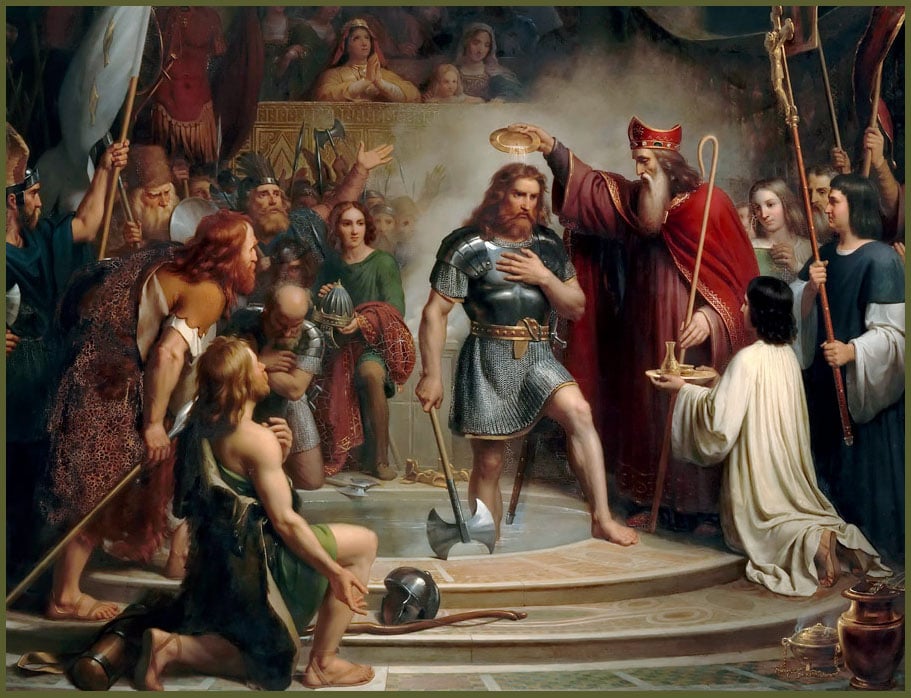
If most of the kings of France were crowned in this cathedral, it’s because a major historical event took place there around the year 500: the baptism of Clovis, the first King of France!
Back in the Middle Ages, the baptism of Clovis, King of France was and still is considered as the founding act of the French Kingdom. When you visit the cathedral of the Kings with Normandy American Heroes, you will see at the top of the tower, in the middle, the mythical baptism of Clovis with at his side, his wife Clotilde, Queen of France and the archbishop, Saint Remi (Saint Remigius).
Historians throughout centuries have tried desperately to find the vestige of the bathysphere where Clovis was baptized. Did they succeed? Well, let’s not forget that the cathedral today is built exactly at the same place as at the time of the coronation of Clovis, King of France. So yes, the archeologists were finally able to identify the bathysphere under today’s nave. It’s in the 1990’s that the archeologists under the supervision of Robert Ness found it underneath the floor of the nave. They later confirmed that the vestiges do date back to the Middle Ages and that what is left of it is a bathysphere bath. The bathysphere of Clovis is approximately 1.5 meters under the ground and dates back to the epoch of the first cathedral of Reims.
Regretfully we know almost nothing of the first cathedral built during the V century as they are no written traces of it. A second cathedral will replace the first one during the IX century, then a third one will be built during the XII century. At each period, the cathedral would get bigger, larger, taller destined to crown the Kings of France in all their glory!
In 1207, the XII century cathedral is burnt down. Four years later in 1211 it was decided to build another cathedral, the fourth one! It’s this megastructure that still exist and stand today in Reims.
You could ask yourself, why rebuild a new cathedral in 1211 when the actual cathedral had been built less than 60 years prior? Surely it could have been restored. Well the simple answer was that in between those two periods there were a lot of profound mutation of styles. First in Paris in 1163, with the construction of Notre-Dame-de-Paris cathedral, who was to be 120 meters long. A megastructure that was going to surpass all the other cathedrals of France! Then you had Bourges and Chartres cathedrals whose edifice at that time were also very innovative.
In no way, decides the clergy of Reims, would they be overtaken by the other cathedrals of France! The cathedral of the Kings of France has to be bigger, longer, taller and the most beautiful of all.
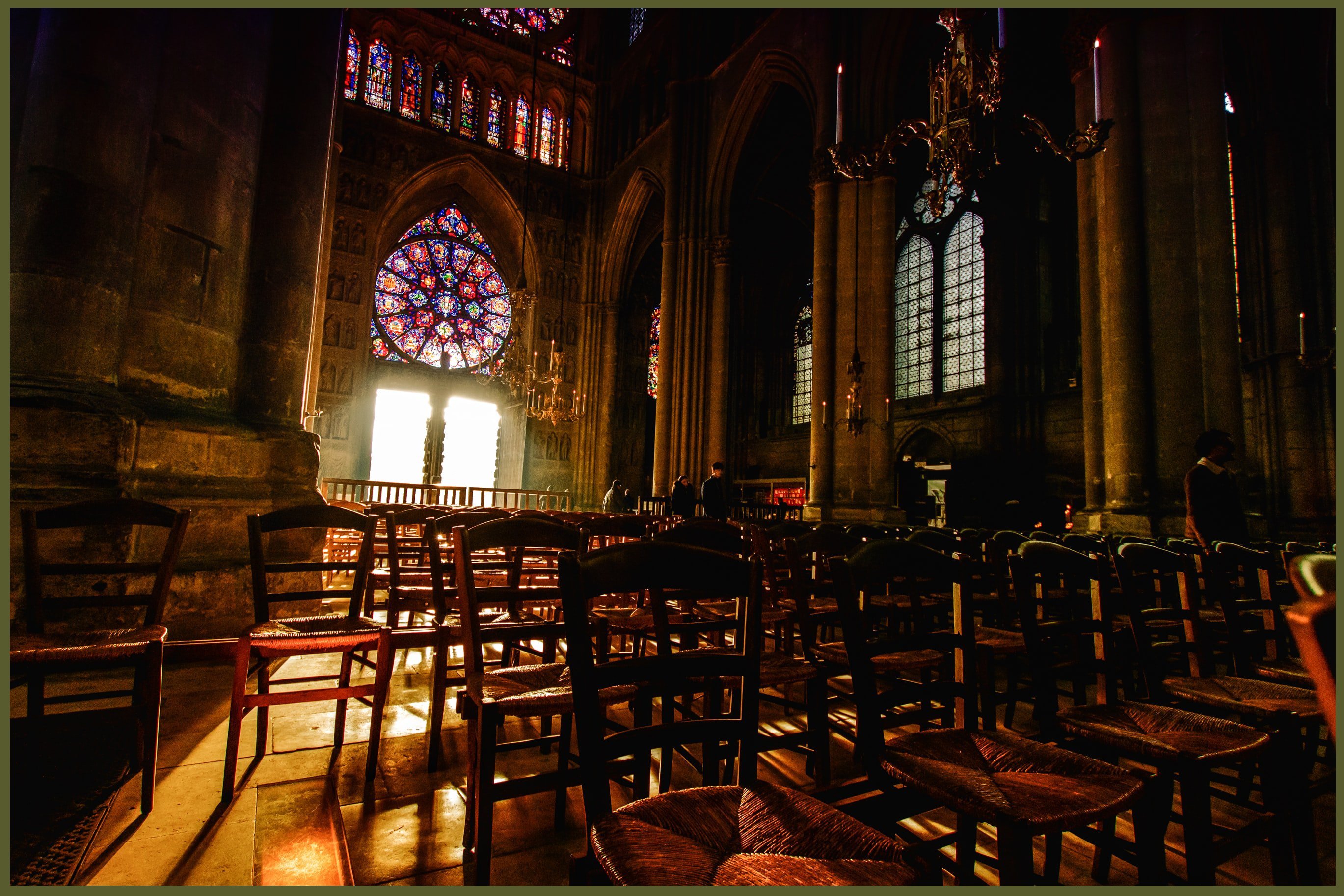
Therefore, at the beginning of the XIII century, the construction site of the cathedral of Reims is the largest ever seen at the time in France. The birth of the new cathedral was at the time considered a record as built in a very short period while being the tallest and longest. Reims will trigger the outbid of other sites to try to realize bigger megastructures!
Each pillar, arcade, staircase etc.… is much more imposing than in any other cathedral built during that time period. How so? Notre-Dame-de-Reims only has five chapels, but each chapel could welcome easily the size of a classical church! The architects at the time chose to use less elements, but colossal elements.
Following the lead of the cathedral of Paris and Chartres, the architects of Reims decide to use the gothic style, an architectural style born one century earlier, but they push the concept even further by building the towers even higher. The towers of Notre-Dame-de-Reims are 12 meters higher than Notre-Dame-de-Paris!
In Reims they are also going to make the choice of a slenderness style with, 38 meters from the floor to the vault of the cathedral, the highest of all at the time of its conception. When you look up, through the windows, you are taken to the sky, closer to God. That’s the second slenderness style of the cathedral realized by the architects, to let in the maximum of lights inside. That was the main goal of the architects, that the lights illuminate the interior of the cathedral by eliminating as much as possible the stonework of the walls. The central span of the cathedral is thus bathing in light.
Yes, you could say it’s an architecture of line and lights! And to achieve this incredible enlightenment the architects had to evolve in their craftsmanship.
To let in the light of God in this huge stone vessel, the walls had to disappear, and the windows seen everywhere.
The exceptional feat is that Notre-Dame-de-Reims has altogether 80 huge windows for a total of 4000m2 which enables the light to shine thru. It’s four times more than at Notre-Dame-de-Paris cathedral!
Overall, the masonry disappears to let as much light in as possible. The walls therefore are thinner and welcome numerous openings and as unbelievable as this may be, Notre-Dame-de-Reims has no bearing walls!
This megastructure is able to welcome under its nave a 14-stories building which resist thanks to the genius of the builders and to the geometrical calculations!
How did those Middle Ages architects achieve this wonder? To enable this cathedral to stand, with openings everywhere, the architects resorted to a major technical feat: the vault of the cathedral are on crossed ogives.
How so? The vault on crossed ogives enables to distribute the force and the weight coming from the vault toward the pillars and the floor. This technic reinforces the crossed ogives by distributing the weight onto the central pillars to have a very efficient descent of the weight all the way down to the floor.
Still, this is not enough to reinforce the crossed ogives vault. Therefore, the architects imagine additional structures placed at the exterior of the walls of the cathedral, the famous flying buttresses. Their purpose is to orientate to the exterior of the building and then to the ground the weight of the crossed ogives. This complimentary technique will ease the weight of the vault on the pillars and avoid having to have bearing walls inside the cathedral. As such, it can welcome all kinds of different openings without having the risk of weakening the structure itself! It was and still is considered an incredible technical and engineering feat!
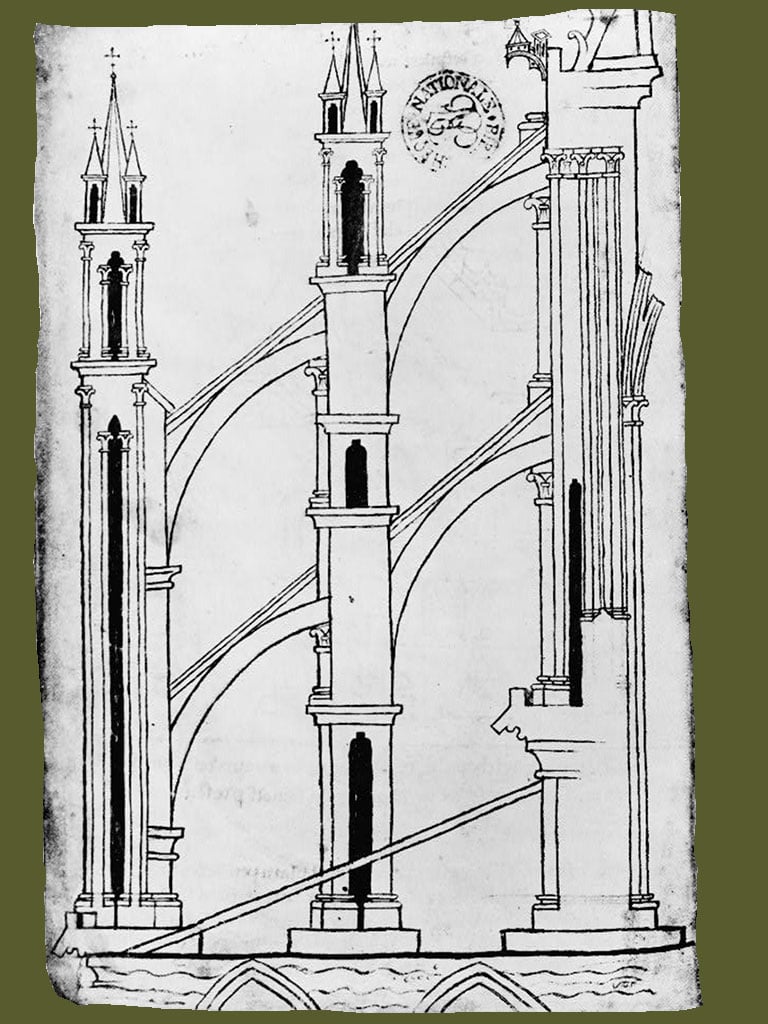
Let’s not forget, as for other French cathedrals line Notre-Dame-de-Strasbourg that the flying buttresses have another important and crucial function: to evacuate thru a very efficient network of pipes the evacuation of the rain! The rain gutters, well hidden, ended up at its extremity on the gargoyles!
Because all had to be magnificent, the architects decorated the flying buttresses with statues and even pierced the walls of the flying buttresses so that the followers looking up could see thru all the way to the nave!
Two centuries, that’s how long the construction site was scheduled to last but thanks to the successive architects who are going to work on this daunting project, the construction will be executed in record time.
The construction works starts off in 1211 and in 1241 the choir is achieved and functional. The Canon can pray in the choir. When you think about it, 30 years to build the choir is quite an achievement. The construction work then stops as they run short of finance. It restarts 9 years later, in 1250 and around 1275 the structural work is completed. In total, Notre-Dame-de-Reims was built in less than 60 years, a record at that time! It’s three time less than what it took to build Notre-Dame-de-Paris, 180 years!
To say the least, Notre-Dame-de-Reims was built in record time thanks to the huge finance it had but also because the construction work was rationalized and standardized from the start. Common business practice today, but back then?
If today we know so well the construction technics used during the Middle Ages it’s thanks to the famous and renowned architect or master mason, Villard de Honnecourt. He is famous for having traveled throughout Europe and realized sketches of all the magnificent construction sites of the XIII century. When he arrives in Reims, he is stunned by how fast the work is accomplished to build the cathedral. He discovers there a new technic of construction seen nowhere else, “the standardization”!
What does it mean, standardization, at that period? To resume, the masons prepared outside of the construction site the cut of the stones, which are then numbered, following the plan of the master mason. (At the Mont-Saint-Michel, stones that came from the Chaussey Island were also numbered, but it was mainly for the stone worker to be paid!) Then a different mason would take the stone and put it in place based on the plan and number of the stone. This ingenious technic of numbering all the stones enabled the workers to assemble the structure in record time. Even today, architects are still fascinated by what their predecessors realized during the Middle Ages!

In Reims, the builders are also going to invent a new style of window which will become famous worldwide: “la fenêtre Rémoise” (the Reims window).
“La fenêtre Rémoise” is something new. The window is mounted like a wooden or metal frame, detached from the masonry in which it is located. It is composed of two lancets surmounted by a rose with six lobes. This stone frame is made up of a large number of carefully marked elements that will be able to be reproduced in series, and which will therefore save manufacturers precious time. The masons mount the walls and then fill the voids with these stone frames: for the low windows, the triforium, the high windows.
The result is that the window is no longer part of the wall, but independent. Those famous window frames will be made on the ground, and then assembled in the edifice from the scaffolding. Needless to say, that with “la fenêtre Rémoise”, the craftsmen conceived a modern frame independent from the walls like we still know it today.
First the walls are built, then the part which is empty is filled in with the frame of “la fenêtre Rémoise” but more so, all the windows of Notre-Dame-de-Reims are mounted in series, meaning they are interchangeable!
After completing Notre-Dame-de-Reims windows, “la fenêtre Rémoise” was copied and used throughout Europe thus imposing itself as one of the Gothic standards of the architecture of that time period.
Also, for the construction of the King’s cathedral, the architects are going to build an imposing wooden framing of incredible modernity. In contrast to the previous wooden frame used for cathedrals, made of heavy and complex elements to assemble, Notre-Dame-de-Reims was conceived to be very light and easy to assemble 50 meters above the ground!
At this Gothic epoch, one of the craftiness of the builders is the invention of the firm rafter (chevron)! It’s a triangular piece of wood made in series which is the masterpiece of the wooden frame of the roof. Instead of having huge structural beams weighting a lot, like the famous “forest” of Notre-Dame-de-Paris, for this cathedral you will have repetitive triangular pieces of wood that can be aligned one after the other on the totality of the edifice.
The wooden framework of Notre-Dame-de-Reims was made so as to have a very sharp incline or steepness at 65° to rise even further toward the sky and God. It’s one of the steepest inclines of any Gothic Cathedral of France, steeper than Notre-Dame-de-Paris!
To say the least, this megastructure hides other secrets and innovations! Two passages at mid-level pierced thru the walls enables you to go around the whole structure. First of all, the triforium situated 20 meters above the floor composed of repetitive models of 5 meters high.
Triforium or interior gallery exist of course in other cathedrals but at Notre-Dame-de-Reims it has a second passage at the level of the windows, passage dug into the pillars, the “Champenois passage” (le passage Champenois). Having both the triforium and Champenois passage enables the clergy to clean and maintain the cathedral.
When special occasions occur like the coronation of the king, those two galleries could also welcome the crowd. To realize those technological marvels the master masons of the Middle Ages asked for and required a dozen or so workers specialized in cutting the stone who were very well paid. A great number of qualified work force was also required.
In total, a monumental cathedral construction site mobilizing approximately 200 people, who, as the cathedral rose from the ground, will grow with her in skills and competencies! If at first the sculptor wasn’t too comfortable in working the stone, as time went by, he became more and more efficient in his task.
You could say that the elevation is not only of the edifice but also of the workers!
To erect such a majestic edifice, the stones to be used had to be of extreme resistance but this would impose a major difficulty for the master craftsmen of the XIII century as the city of Reims is built with limestone coming from local underground quarries. The limestone is extremely fragile and friable therefore the builders decided not to use that stone as it could fragilize the structure or render it unstable.
They will prospect in the region and find, about 40 kilometers from Reims, a calcareous stone with great qualities. Let’s not forget though, that Notre-Dame-de-Reims cathedral is not made just of stones. Other materials were used for the edifice, some used were totally unexpected!
The Cathedral is a huge stone vessel but has also a wooden structure for the roof and all kinds of small metal elements to reinforce the edifice. Local blacksmith made the small metal elements to be used where the edifice structure would be the most challenged. Among those, the large rose which is situated at the front of the facade.
Since the XIII century, huge metal bars were sealed with lead to guarantee the solidity of the 11 meters diameter large rose of the facade. This technic was also used in other cathedrals like Notre-Dame-de-Strasbourg, which you will discover in another heritage blog of Normandy American Heroes.
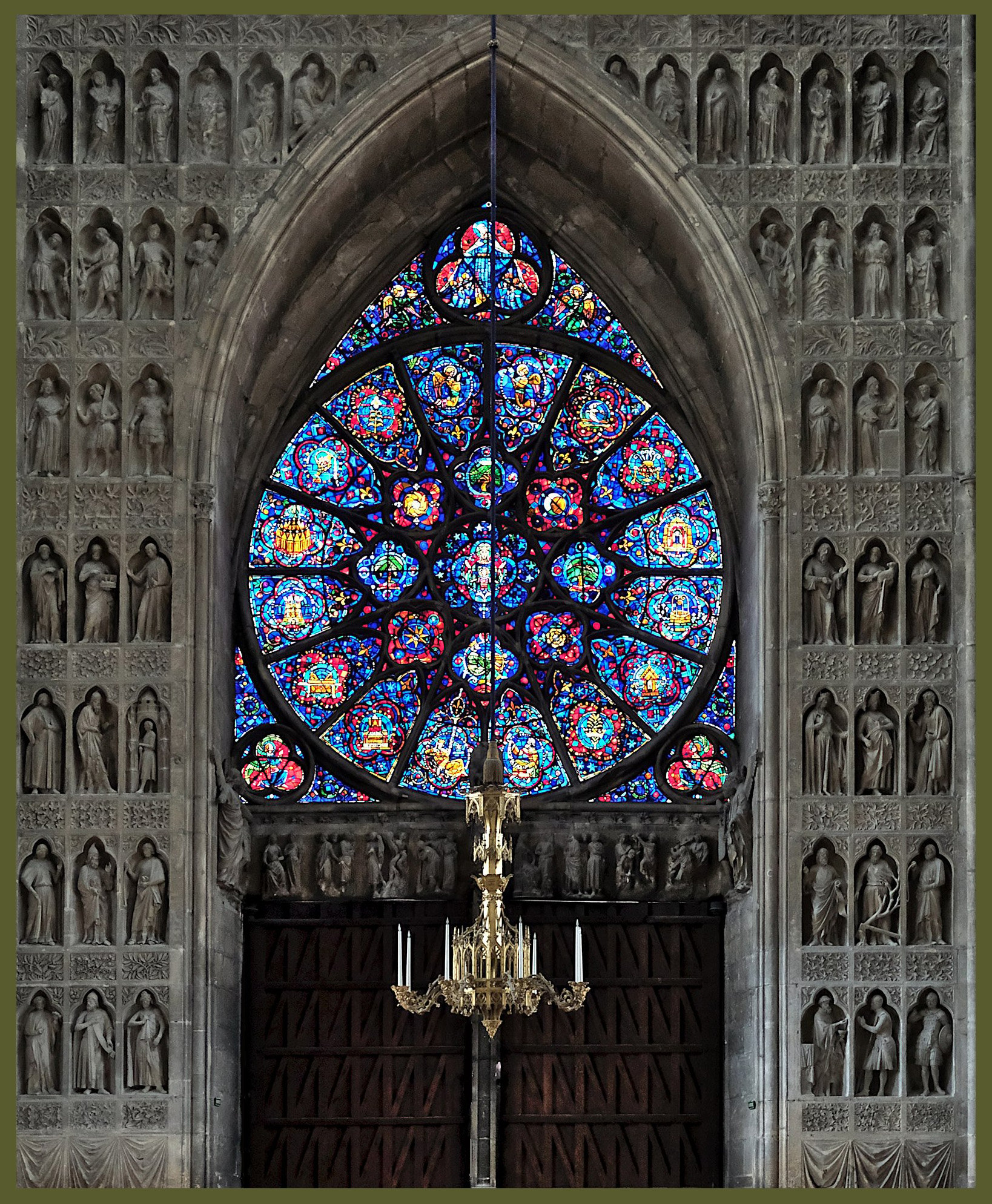
Another exceptional feat at the time is situated just under the large rose. There you have a smaller rose. Why? So as to bathe the nave with a maximum of light.
The result being, at any time of the day, the set of lights changes as if you discover for the first time the interior of the cathedral!
At that epoch the Gothic glows everywhere in France but in Reims the master masons are going to go even further by making the facade with the large rose truly transparent.
What’s magic today, additional to the large rose of the XIII century which survived the great fire, WWI and WWII, remains some beautiful windows of that period:
- The gallery of the coronation of the King
- The three large windows of the apse (rear view of the cathedral)
In Reims, the master glassmaker realized some of the most beautiful windows that still exist today in Europe! Needless to say, that the role of these artists of art was essential because it’s almost impossible to paint on the walls large fresco mainly because the walls are so thin! They are replaced by the great stained-glass windows which now tells the stories of the bible to the followers.
The image becomes light.
The followers could then read what is shown on the stained-glass windows like a cartoon.
Those huge windows are book of images (don’t forget that the average person at that epoch did not know how to read, this was reserved on purpose to the clergy and elite). When you look closer at the large rose you will notice that it tells the story of the death of the Virgin Mary surrounded by the Angels who prepare themselves to take her up to heaven. More so, from the exterior, in front of the rose you have afterward the continuation of her story: The Virgin Mary welcomed by Jesus Christ in heaven who puts a crown on her head.
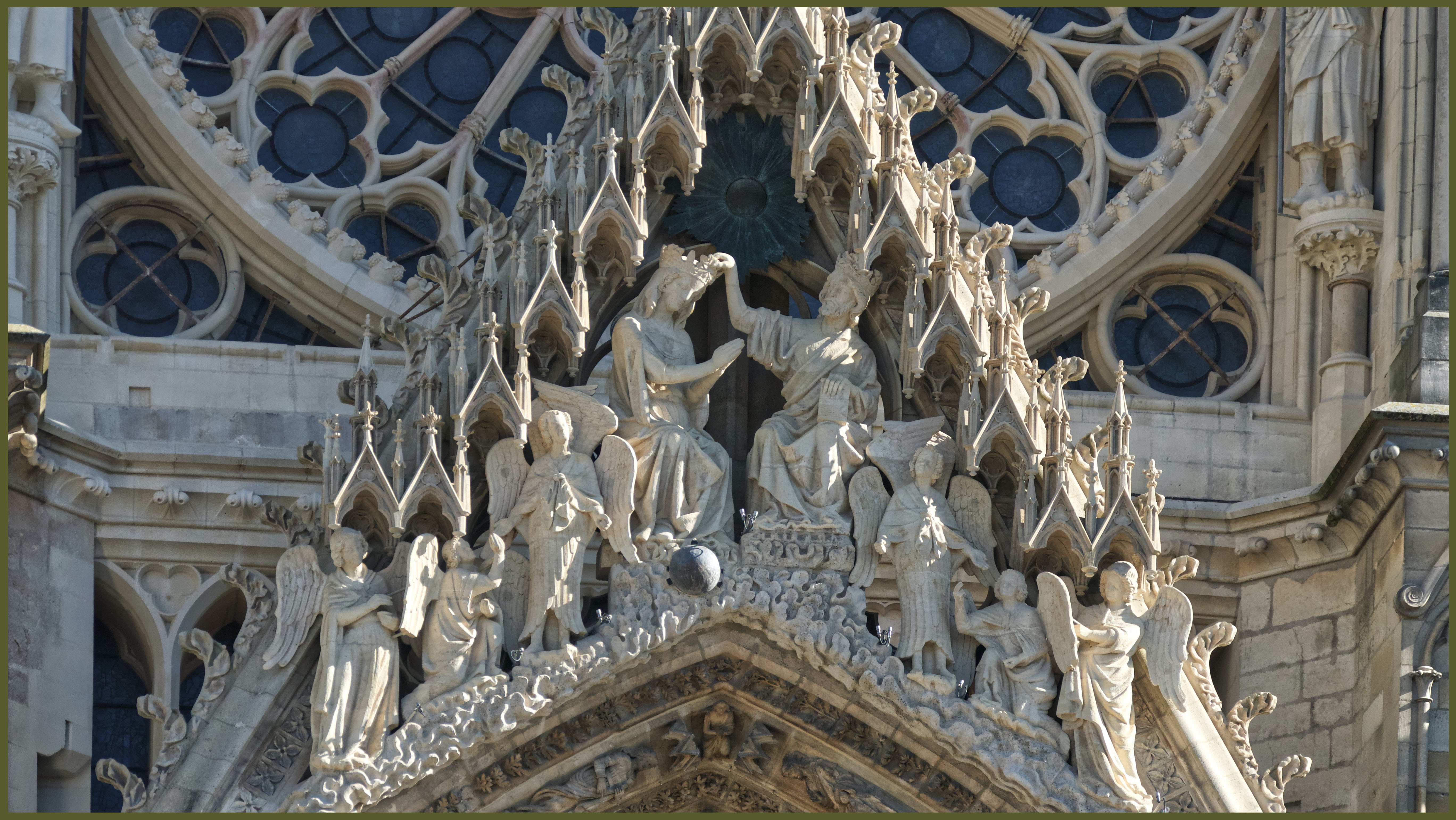
Notre-Dame-de-Reims is unique as from the inside out, it tells a continuous story thru its huge stained-glass windows and statues. More so, the interior back of the facade of the large rose has no equivalent in the world! It’s entirely sculpted! (see picture just above) About 40 statues tell the story of Jesus Christ from his birth to his baptism. His life story continues outside on the facade with a representation of his crucifixion and resurrection above the lateral entrance of the cathedral.
The builders will also build on the facade and the apse statues meant to address directly the future King of France at the precise moment of his coronation. How? Imagine, when the future King of France arrives at the main entrance of Notre-Dame-de-Reims cathedral, he visualizes the representation of the baptism of Clovis above him and sees the 56 statues of the King’s gallery as well. Colossal stone statues of 5 meters high!
No need to waste your time to try to recognize among the statues the face of a King of France, you won’t find one. Why? The stone workers were not going to make every time a king was crowned a statue of his effigy! No, the idea was to represent the continuity of the coronation of the King of France, a universal royalty which was to take the people of France to the kingdom of heaven. To this gallery of fictitious kings on the façade, answers inside the cathedral, a stained-glass window gallery representing the coronation of a king of France during the XIII century.
Let’s not forget that almost all the Kings of France were crowned at Notre-Dame-de-Reims. Probably so because of its magnificence and size to welcome all the followers. Why magnificence? The coronation space is almost 70 meters long whereas the total length of the interior of the cathedral is 138 meters long!
The coronation of the king at Notre-Dame-de-Reims is a unique ceremony. Contrary to appearances it’s not just the consecration or coronation of the king of France. Don’t forget that in medieval time, the coronation is very rare in the western hemisphere, what we call occident. Only three kings were coronated:
- The Emperor of the Germanic Empire
- The King of France
- The King of England
All the other monarchs were crowned. The coronation is a political construction which associates the anointing like a baptism to the crowning.
In France this ceremony directly refers to the baptism of Clovis, the first of the Kings of France. All the kings of France, without exception, had to follow the same ritual in Notre-Dame-de-Reims and solemnly promise to put the King’s sword to the service of God and justice. He was then crowned by the archbishop. Then, during the communion, he drank the wine in the golden chalice preciously kept in the cathedral and exposed today at the Palace of Tau.
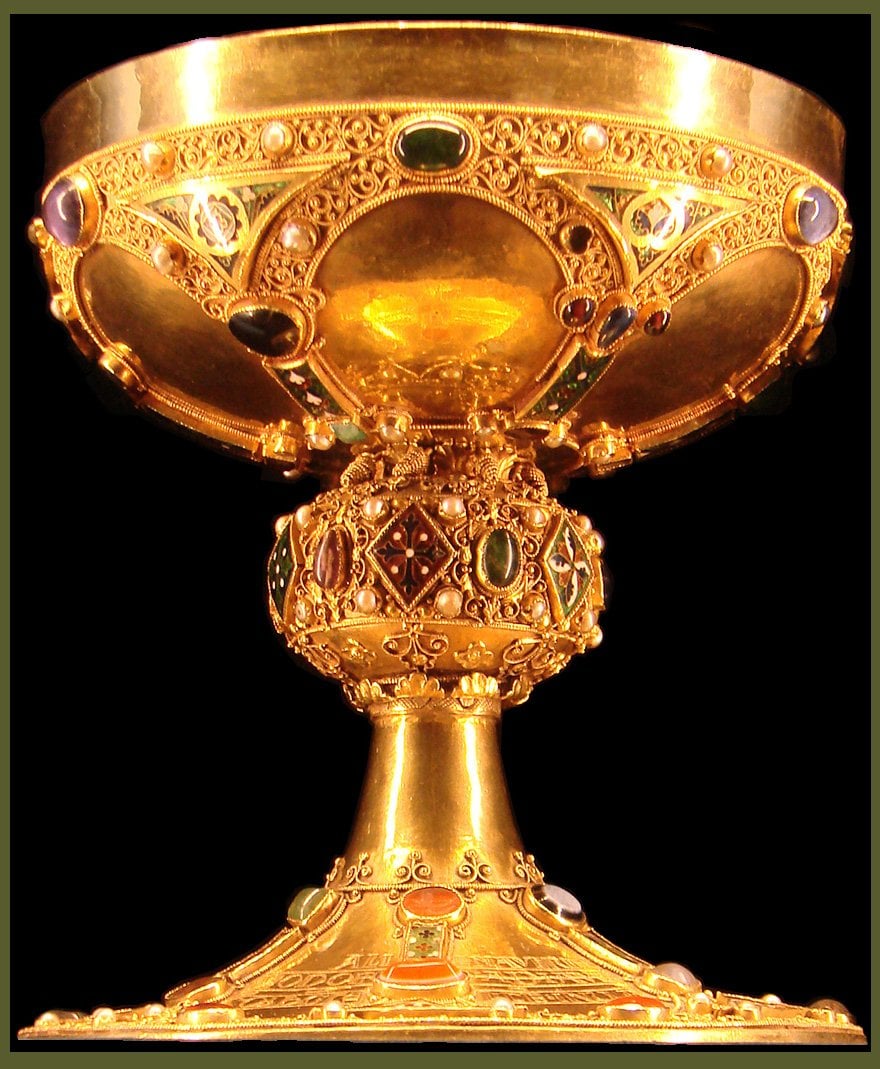
25 of the 33 Kings of France drank from this sacred chalice! Most importantly, the newly crowned king received an anointing of the Saint Oil, the sacred chrism sent by God for the baptism of Clovis.
This anointing confers to the new king of France the essence of his power given directly by the hand of God. At the precise moment of the anointing, there is a radical change, the king who has been anointed by the hand of God, chosen thus by God with a very particular mission on earth, protected by God, cannot be ever physically touched by the common mortal!
To say the least, it is Notre-Dame-de-Reims who makes the King of France! It’s simply unconceivable that the coronation could take place anywhere else.
The coronation of Charles VII right in the middle of the 100 years’ war (1337 – 1453) in 1429 is emblematic of the importance of Notre-Dame-de-Reims cathedral for the French monarchy. At that epoch, the English wanted to impose to the French their King as the monarch of France! But thanks to Joan of Arc who is going to change the course of history, she will take safely Charles VII to Reims where he will be crowned King of France.
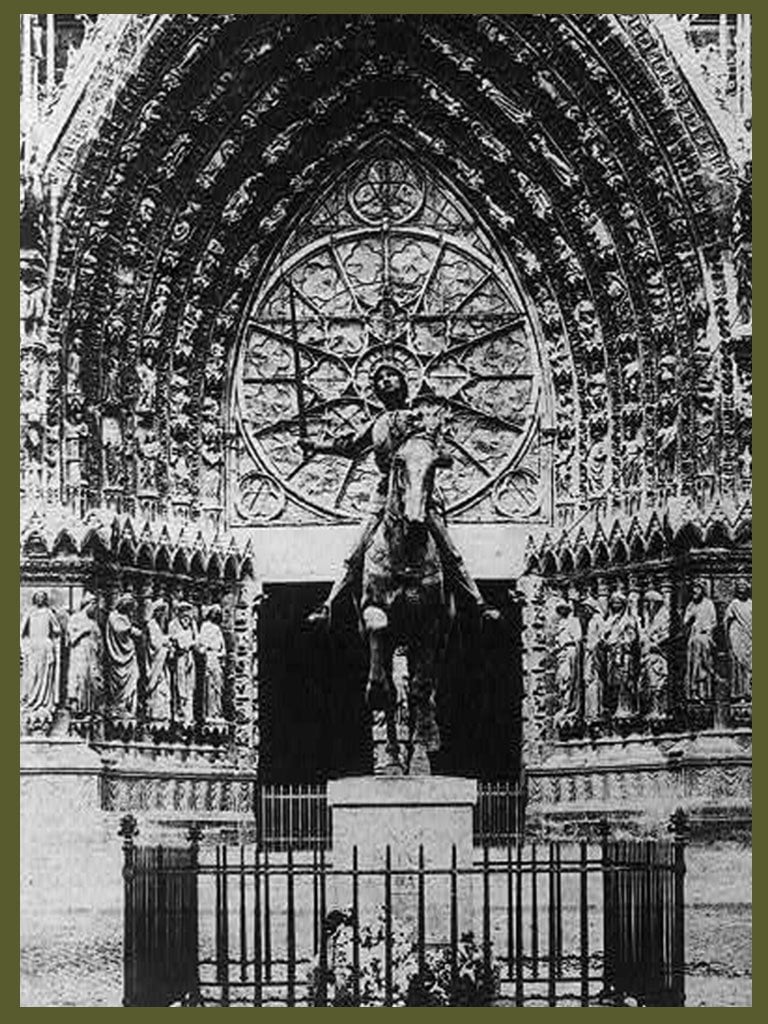
But why Reims you may ask? Because it’s the town of legitimacy, of the people and has been so for the last 150 years! Notre-Dame-de-Reims cathedral is part of France history and heritage; therefore, the king of France can only be king if he has been crowned where Clovis had been, at Notre-Dame-de-Reims!
To resume, the coronation of Charles VII in Reims demonstrated and confirmed the legitimacy of Notre-Dame-de-Reims cathedral as the cathedral of the Kings.
The King of England, Henry VI, who had been crowned in 1429 at Westminster Abbey at the age of 7 came to Reims two years later to be crowned there as well…! It can still be said today that it was worthless, deprived of pertinence and legitimacy!
Even though Notre-Dame-de-Reims cathedral is where all the kings of France were coronated, it welcomes also thousands and thousands of followers thanks to its sheer size: 6500 m2
Up to 6000 followers can easily come in to attend the mass service, as the common people were not allowed to sit, only to kneel or stand up! That’s pretty much half of the population of the town of Reims when the cathedral was being built and half of the population of Bayeux – Normandy where Normandy American Heroes headquarters is! Back in the Middle Ages, the cathedral became the emblem of the town of Reims, welcoming the whole population for mass service.
Like the Cathedral of Bayeux, Chartres, Amiens, Strasbourg, Paris etc.… the people could see the landmark of the cathedral from far away in the country. It’s easily recognizable, thus the emblem of the town. For example, when Normandy American Heroes takes its guests along the coastline toward Omaha beach, on the south side of the road they can easily see the cathedral of Bayeux and its spires, more or less 12 km away!
The twin towers of Notre-Dame-de-Reims are 81.5 meters high, Notre-Dame-de-Bayeux 77 meters high. The stone vessel crushes of its magnificence the Middle Age town of Reims whose houses were no more than one story high.
Just imagine at that time being confronted to an incommensurable edifice which at that epoch is simply a “miracle”, how would you feel! More so, when you looked up and walked around the cathedral and saw everywhere statues of angels with their wings open, surely you

















